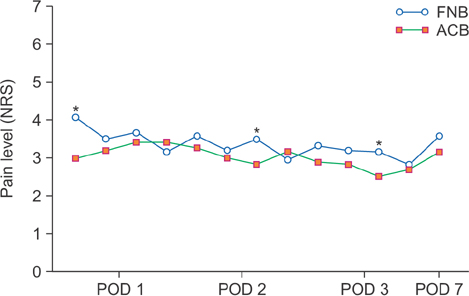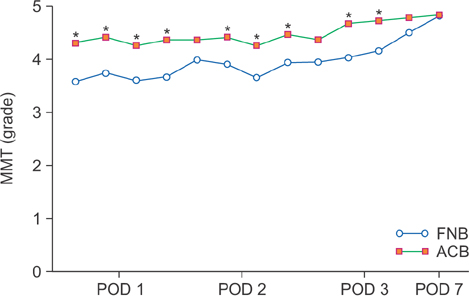Clin Orthop Surg.
2017 Sep;9(3):303-309. 10.4055/cios.2017.9.3.303.
Comparison of the Effect of Continuous Femoral Nerve Block and Adductor Canal Block after Primary Total Knee Arthroplasty
- Affiliations
-
- 1Department of Orthopedic Surgery, Bumin Hospital, Busan, Korea. wellknee@gmail.com
- KMID: 2412266
- DOI: http://doi.org/10.4055/cios.2017.9.3.303
Abstract
- BACKGROUND
This study aimed to compare the effects of femoral nerve block and adductor canal block on postoperative pain, quadriceps strength, and walking ability after primary total knee arthroplasty.
METHODS
Between November 2014 and February 2015, 60 patients underwent primary total knee arthroplasty. Thirty patients received femoral nerve block and the other 30 received adductor canal block for postoperative pain control. Before spinal anesthesia, the patients received nerve block via a catheter (20 mL 0.75% ropivacaine was administered initially, followed by intermittent bolus injection of 10 mL 0.2% ropivacaine every 6 hours for 3 days). The catheters were maintained in the exact location of nerve block in 24 patients in the femoral nerve block group and in 19 patients in the adductor canal block group. Data collection was carried out from these 43 patients. To evaluate postoperative pain control, the numerical rating scale scores at rest and 45° flexion of the knee were recorded. To evaluate quadriceps strength, manual muscle testing was performed. Walking ability was assessed using the Timed Up and Go test. We also evaluated analgesic consumption and complications of peripheral nerve block.
RESULTS
No significant intergroup difference was observed in the numerical rating scale scores at rest and 45° flexion of the knee on postoperative days 1, 2, 3, and 7. The adductor canal block group had significantly greater quadriceps strength than did the femoral nerve block group, as assessed by manual muscle testing on postoperative days 1, 2, and 3. The 2 groups showed no difference in walking ability on postoperative day 1, but on postoperative days 2, 3, walking ability was significantly better in the adductor canal block group than in the femoral nerve block group. No significant intergroup difference was observed in analgesic consumption.
CONCLUSIONS
The groups showed no difference in postoperative pain control. Adductor canal block was superior to femoral nerve block in preserving quadriceps strength and walking ability. However, adductor canal block was inferior to femoral nerve block in maintaining the exact location of the catheter.
MeSH Terms
Figure
Cited by 2 articles
-
Comparison of the Clinical Outcomes of a Single Injection Adductor Canal Block with the Concomitant Use of Transdermal Buprenorphine and Continuous Adductor Canal Block after Total Knee Arthroplasty
Huh Jung-Wook, Park Man-Jun, Ko Young-Chul, Ha Dong-Jun, Park Joon-Hyung, Lee Woo-Myung
J Korean Orthop Assoc. 2019;54(5):411-417. doi: 10.4055/jkoa.2019.54.5.411.New insight into the vasto-adductor membrane for safer adductor canal blockade
Yanguk Heo, Miyoung Yang, Sung Min Nam, Hyun Seung Lee, Yeon-Dong Kim, Hyung-Sun Won
Korean J Pain. 2024;37(2):132-140. doi: 10.3344/kjp.23292.
Reference
-
1. Bonica JJ, Loeser JD, Chapman CR, Fordyce WE. The management of pain. 2nd ed. Philadelphia, PA: Lea and Febiger;1990. p. 461–480.2. Strassels SA, Chen C, Carr DB. Postoperative analgesia: economics, resource use, and patient satisfaction in an urban teaching hospital. Anesth Analg. 2002; 94(1):130–137.
Article3. Jeong MS, Song EK, Seon JK, Byun JW, Lee KJ, Jung YW. Effectiveness of pain relief for femoral nerve block in multimodal pain control protocols in total knee arthroplasty. J Korean Orthop Assoc. 2011; 46(3):237–243.
Article4. Paul JE, Arya A, Hurlburt L, et al. Femoral nerve block improves analgesia outcomes after total knee arthroplasty: a meta-analysis of randomized controlled trials. Anesthesiology. 2010; 113(5):1144–1162.
Article5. Choy WS, Lee SK, Kim KJ, Kam BS, Yang DS, Bae KW. Two continuous femoral nerve block strategies after TKA. Knee Surg Sports Traumatol Arthrosc. 2011; 19(11):1901–1908.
Article6. Charous MT, Madison SJ, Suresh PJ, et al. Continuous femoral nerve blocks: varying local anesthetic delivery method (bolus versus basal) to minimize quadriceps motor block while maintaining sensory block. Anesthesiology. 2011; 115(4):774–781.7. Jaeger P, Nielsen ZJ, Henningsen MH, Hilsted KL, Mathiesen O, Dahl JB. Adductor canal block versus femoral nerve block and quadriceps strength: a randomized, double-blind, placebo-controlled, crossover study in healthy volunteers. Surv Anesth. 2013; 57(4):199–200.8. Lund J, Jenstrup MT, Jaeger P, Sorensen AM, Dahl JB. Continuous adductor-canal-blockade for adjuvant post-operative analgesia after major knee surgery: preliminary results. Acta Anaesthesiol Scand. 2011; 55(1):14–19.
Article9. Yeung TS, Wessel J, Stratford P, Macdermid J. Reliability, validity, and responsiveness of the lower extremity functional scale for inpatients of an orthopaedic rehabilitation ward. J Orthop Sports Phys Ther. 2009; 39(6):468–477.
Article10. Ilfeld BM, Duke KB, Donohue MC. The association between lower extremity continuous peripheral nerve blocks and patient falls after knee and hip arthroplasty. Anesth Analg. 2010; 111(6):1552–1554.
Article11. Johnson RL, Kopp SL, Hebl JR, Erwin PJ, Mantilla CB. Falls and major orthopaedic surgery with peripheral nerve blockade: a systematic review and meta-analysis. Br J Anaesth. 2013; 110(4):518–528.
Article12. Grevstad U, Mathiesen O, Valentiner LS, Jaeger P, Hilsted KL, Dahl JB. Effect of adductor canal block versus femoral nerve block on quadriceps strength, mobilization, and pain after total knee arthroplasty: a randomized, blinded study. Reg Anesth Pain Med. 2015; 40(1):3–10.
Article13. Kim DH, Lin Y, Goytizolo EA, et al. Adductor canal block versus femoral nerve block for total knee arthroplasty: a prospective, randomized, controlled trial. Surv Anesth. 2014; 58(4):199–200.
Article14. Nielsen KC, Klein SM, Steele SM. Femoral nerve blocks. Tech Reg Anesth Pain Manag. 2003; 7(1):8–17.
Article15. Ng HP, Cheong KF, Lim A, Lim J, Puhaindran ME. Intraoperative single-shot “3-in-1” femoral nerve block with ropivacaine 0.25%, ropivacaine 0.5% or bupivacaine 0.25% provides comparable 48-hr analgesia after unilateral total knee replacement. Can J Anaesth. 2001; 48(11):1102–1108.
Article16. Shah NA, Jain NP, Panchal KA. Adductor canal blockade following total knee arthroplasty-continuous or single shot technique? Role in postoperative analgesia, ambulation ability and early functional recovery: a randomized controlled trial. J Arthroplasty. 2015; 30(8):1476–1481.
Article17. Hunt KJ, Bourne MH, Mariani EM. Single-injection femoral and sciatic nerve blocks for pain control after total knee arthroplasty. J Arthroplasty. 2009; 24(4):533–538.
Article
- Full Text Links
- Actions
-
Cited
- CITED
-
- Close
- Share
- Similar articles
-
- The relative analgesic value of a femoral nerve block versus adductor canal block following total knee arthroplasty: a randomized, controlled, double-blinded study
- Does Combination Therapy of Popliteal Sciatic Nerve Block and Adductor Canal Block Effectively Control Early Postoperative Pain after Total Knee Arthroplasty?
- Femoral Nerve Block versus Adductor Canal Block for Analgesia after Total Knee Arthroplasty
- Can bedside patient-reported numbness predict postoperative ambulation ability for total knee arthroplasty patients with nerve block catheters?
- Effect of Regional Nerve Block in Total Knee Arthroplasty






